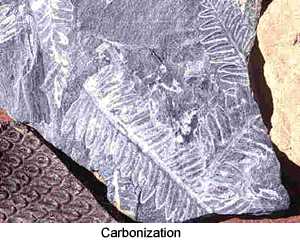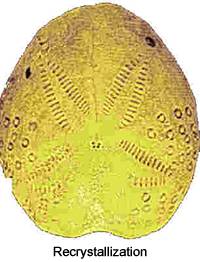BACKGROUND:
 Fossils
are the remains of plants and animals that lived long ago. The
probability that an organism will be preserved as a fossil is very low.
Geological processes such as erosion, weathering, sedimentation, and
leaching constantly "attack" the fossil, and may destroy it before
anyone sees it. Fossils
are the remains of plants and animals that lived long ago. The
probability that an organism will be preserved as a fossil is very low.
Geological processes such as erosion, weathering, sedimentation, and
leaching constantly "attack" the fossil, and may destroy it before
anyone sees it.
There are two main types of fossil preservation, with
alteration and direct preservation. Most common is fossil
preservation with alteration; the original organic material is partially to
fully changed into new material. There are several types of preservation
with alteration:
- carbonization, a chemical reaction where water transforms the organic
material of plant or animal to a thin film of carbon. Nitrogen,
hydrogen, and oxygen are driven off as gases, leaving an outline of the
organism. Organisms often preserved by carbonization include fish,
leaves and the woody tissues of plants.
- permineralization or petrifaction takes place in porous materials such
as bones, plants and shells. The material is buried; later, groundwater
percolates through its pore spaces. A solution, commonly supersaturated
in either calcium carbonate or silica, precipitates minerals in the
spaces. The original wood or shell like material preserved.

- recrystallization occurs when a solution or precipitate changes the
internal physical structure of a fossil. Recrystallization changes the
microstructure of the original minerals; they often reform as larger
crystals. The composition of the mineral does not change, only the
crystal structure. For example, many shells originally composed of
calcium carbonate in the form of the mineral aragonite recrystallize
into the more stable form of calcium carbonate called calcite.
- replacement involves the complete removal of original hard parts by
solution and deposition of a new mineral in its place. The Petrified
Forest in Arizona is an excellent example of this type of preservation.
Here the original organic material (wood) has been wholly replaced by
silica.
The second type of fossil creation is direct
preservation, the
preservation of original organic materials. The most common
directly preserved fossils are unaltered hard parts of a living
organism, like shells, teeth, and bones. This material is unchanged,
except for the removal of less stable organic matter. Other examples of
this type of preservation include fossil corals, shells, sponges,
microscopic fossils and a host of other organisms with hard parts. In
rare circumstances, preservation of the soft parts of an organism may
occur. An example is an insect which has become "stuck" in
tree resin. When the resin fossilizes to form amber, it preserves the
insect.
PROCEDURE:
- Show the students different examples of living material, such as
chicken bones, leaves, or tree bark. If you have a live animal in the
classroom, you may also want to use it as an example. Ask the students
what will remain after the organism dies. Lead them into a discussion
about why hard parts such as shells or bones are more likely to be found
in the fossil record then are the soft parts of an organism.
- If you have fossil specimens go over whether they are direct
preservation or with alteration. You may even ask students to
bring in a fossil that they may have at home.
- The Eyewitness Book on Fossils by P. Taylor has wonderful
pictures of fossils for the students to examine. They will see examples
of many of the modes of preservation presented above.
|